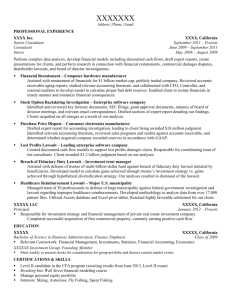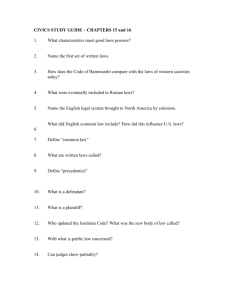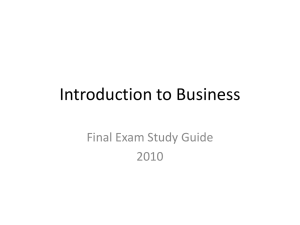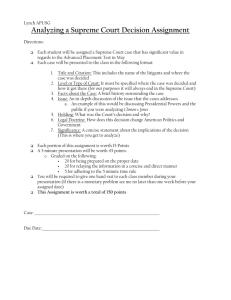CHAPTER 1 test bank student
advertisement
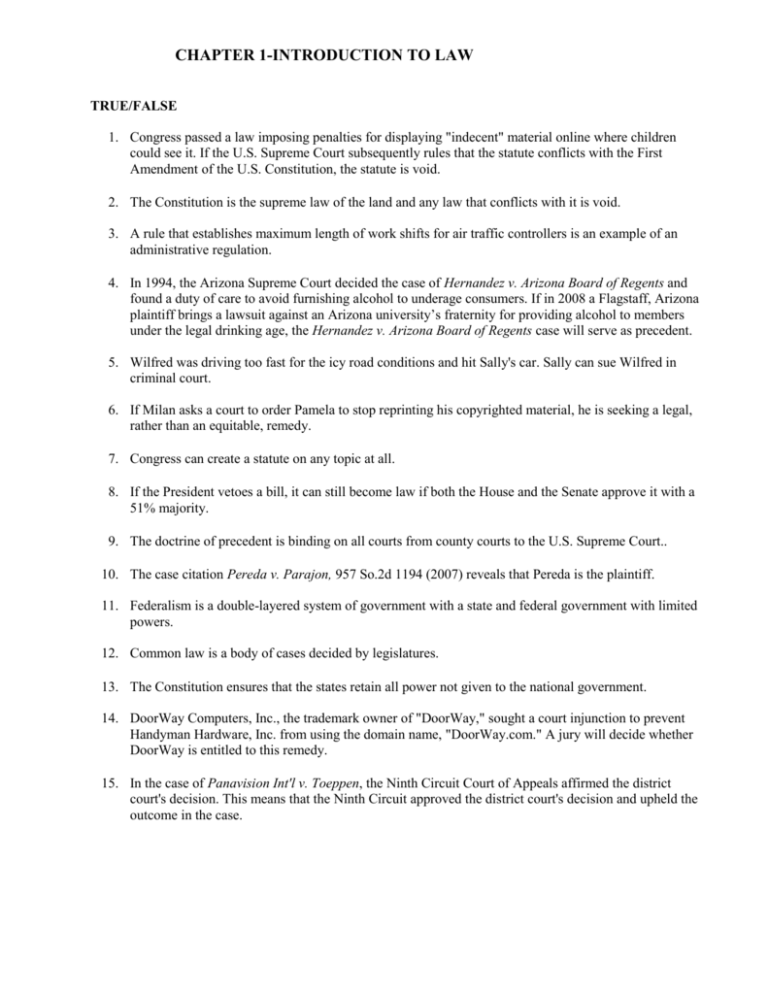
CHAPTER 1-INTRODUCTION TO LAW TRUE/FALSE 1. Congress passed a law imposing penalties for displaying "indecent" material online where children could see it. If the U.S. Supreme Court subsequently rules that the statute conflicts with the First Amendment of the U.S. Constitution, the statute is void. 2. The Constitution is the supreme law of the land and any law that conflicts with it is void. 3. A rule that establishes maximum length of work shifts for air traffic controllers is an example of an administrative regulation. 4. In 1994, the Arizona Supreme Court decided the case of Hernandez v. Arizona Board of Regents and found a duty of care to avoid furnishing alcohol to underage consumers. If in 2008 a Flagstaff, Arizona plaintiff brings a lawsuit against an Arizona university’s fraternity for providing alcohol to members under the legal drinking age, the Hernandez v. Arizona Board of Regents case will serve as precedent. 5. Wilfred was driving too fast for the icy road conditions and hit Sally's car. Sally can sue Wilfred in criminal court. 6. If Milan asks a court to order Pamela to stop reprinting his copyrighted material, he is seeking a legal, rather than an equitable, remedy. 7. Congress can create a statute on any topic at all. 8. If the President vetoes a bill, it can still become law if both the House and the Senate approve it with a 51% majority. 9. The doctrine of precedent is binding on all courts from county courts to the U.S. Supreme Court.. 10. The case citation Pereda v. Parajon, 957 So.2d 1194 (2007) reveals that Pereda is the plaintiff. 11. Federalism is a double-layered system of government with a state and federal government with limited powers. 12. Common law is a body of cases decided by legislatures. 13. The Constitution ensures that the states retain all power not given to the national government. 14. DoorWay Computers, Inc., the trademark owner of "DoorWay," sought a court injunction to prevent Handyman Hardware, Inc. from using the domain name, "DoorWay.com." A jury will decide whether DoorWay is entitled to this remedy. 15. In the case of Panavision Int'l v. Toeppen, the Ninth Circuit Court of Appeals affirmed the district court's decision. This means that the Ninth Circuit approved the district court's decision and upheld the outcome in the case. MULTIPLE CHOICE 1. The government itself prosecutes the wrongdoer in a case involving behavior so threatening that society outlaws it altogether. This kind of case involves: a. Procedural law. b. Private law. c. Civil law. d. Criminal law. 2. The Occupational Safety and Health Administration promulgated a rule requiring warehouse employees to wear hardhats when in the vicinity of an operating forklift. The purpose of the hardhats is to protect employees from danger of falling objects. This rule is: a. an executive order. b. a statute. c. common law. d. administrative law. 3. Common law refers to: a. law that is the same or similar in all the states. b. law made when judges decide cases and then follow those decisions in later cases. c. law made by legislatures in the form of statutes. d. the legal systems of France, Germany, and Italy. 4. Hasbro, Inc., the trademark owner of "Candy Land," sought a court injunction to stop Internet Entertainment Group, LTD from using the domain name, "candyland.com." Internet Entertainment Group had established a sexually explicit site at the domain name. This injunction would have to be issued by: a. a jury. b. a judge exercising equitable powers. c. an executive order. d. a subpoena. 5. The three branches of government in the United States are: a. the executive, legislative, and administrative. b. the administrative, executive, and statutory. c. the executive, legislative, and judicial. d. the administrative, legislative, and international. 6. The doctrine of stare decisis: a. makes the legal process more expensive. b. is an equitable remedy. c. makes the law more predictable. d. is unimportant to the common law. 7. In 1992, the North Carolina Supreme Court ruled in a case entitled Goodman v. Wenco Foods, Inc., that when a substance in food causes injury to a consumer of the food, it is not a bar to recovery against the seller that the substance was natural to the food. If, in a 2008 case involving a consumer’s injury caused by a fish bone in a bowl of fish chowder, the court followed the decision in Goodman v. Wenco Foods, Inc., the court's action in the second case is an example of: a. stare decisis. b. statutory law. c. public law. d. criminal law. 8. When the Food and Drug Administration prohibits a certain drug from being marketed in the United States, this is: a. private law. b. an administrative regulation. c. legal negativism. d. an executive order. 9. If the title of an appellate court case appears as Jones v. Smith: a. Jones is the plaintiff and Smith is the defendant. b. Smith won the trial court decision. c. you cannot determine which party is the plaintiff, because when a defendant loses a trial and files an appeal, some courts (but not all) reverse the names of the parties. d. the trial judge was Jones and the appellate judge is Smith. 10. The Minnesota legislature passed a law requiring that employers allow each employee adequate time within each four consecutive hours of work to utilize the nearest convenient restroom. This law is: a. an executive order. b. an ordinance. c. a statute. d. a stare decisis. 11. The doctrine of precedent requires: a. that the victim testify. b. that the defendant testify. c. a 12-member jury of the defendant’s peers. d. judges to base rulings on previous cases. 12. Congress enacted legislation in 1933 to regulate the securities industry and prohibit various forms of fraud with securities. The Securities Exchange Act of 1934 was passed a year later. This law created the Securities and Exchange Commission (SEC) as an independent regulatory entity whose function is to administer the two laws. The SEC has generated rules and regulations to administer these acts. These rules and regulations are: a. statutes. b. administrative law. c. executive orders. d. common law. 13. The federal judicial branch of the U.S. government: a. interprets statutes. b. passes statutes. c. issues executive orders. d. creates administrative agencies. 14. The United States Supreme Court has the power to: a. appoint judges to serve on the Supreme Court. b. declare an act of Congress unconstitutional. c. issue executive orders. d. ratify treaties. 15. The President of the United States: a. creates federal common law. b. can veto Congressional legislation. c. determines the constitutionality of statutes. d. passes statutes. 16. Tony raped Jane in the parking lot of Joe's Brew Pub. The District Attorney's office prosecuted Tony on rape charges. Subsequently, Jane filed a lawsuit against Tony for money damages. Classify each legal action. a. The District Attorney's case was a criminal case; Jane's lawsuit was a civil case. b. The District Attorney's case was a civil case. Jane's lawsuit was a criminal case. c. Both cases are criminal. d. Both cases are civil. 17. President Nixon issued wage-price controls in an effort to stabilize the economy. This use of executive power was: a. an illegal usurption of legislative powers which belong to the Congress. b. a valid use of power, known as an executive order. c. a valid use of power creating a treaty. d. an illegal usurption of the regulatory powers of administrative agencies. 18. Which of the following would be an example of a civil lawsuit? a. George is being prosecuted for bank fraud. b. The government has initiated an action against Jeff for operating a motor vehicle under the influence of alcohol. c. Gretta hit Rita in a bar during happy hour. Rita is now suing for her injuries. d. The district attorney is bringing Ali to court for violating the city's keg ordinance. 19. Curtis filed a lawsuit against Ulhoff for failure to repay $1,000 according to the terms of a promissory note. The trial ended before it began, with the trial judge granting a motion for summary judgment in favor of Curtis. Ulhoff has appealed, and the Supreme Court of Iowa has remanded the case. This means: a. Curtis automatically wins because he won in the lower court. b. Ulhoff automatically wins because he lost in the lower court. c. Neither party wins because the case is being thrown out. d. We don't know who wins yet because the case is being returned to the trial court for additional steps. 20. Which of the following are administrative agencies? a. House of Representatives b. Internal Revenue Service c. Supreme Court d. Bureau of Prisons 21. The issue in Kuehn v Pub Zone was a. Legal Positivism.Can a bar serve drunk patrons? b. Did the bar have a duty to protect its patrons? c. Is a bar allowed to exclude motorcycle riders from the premises? d. Can the government prosecute patrons who get into fights on private property? 22. If an appellate court holds a lower courts decision void it is called: a. a reversal b. a remand c. an affirmation d. nolle pros 23. More Americans law comes from which country? a. France b. England c. Spain d. Aztecs 24. Which school of jurisprudence is based on the philosophy that what matters is not what is written as law, but who enforces the law and by what process? a. Legal positivism. b. Natural law. c. Legal realism. d. Sovereign selection. 25. What are the sources of United States current law? a. the Constitution of the United States b. Court decisions c. Statutes d. all of these answers are correct ESSAY 1. Identify and discuss the primary sources of contemporary U.S. law. 2. Identify and explain the parts of the following case name: Palsgraf v. Long Island Railroad Co., 248 N.Y. 339, 162 N.E. 99, New York Court of Appeals. 3. Peggy Lou filed a lawsuit against "We Fix 'Em Rite," an auto body shop, for the sloppy paint job it did on her 1998 car. Once the lawsuit was filed with the appropriate clerk of court, Peggy Lou personally dropped a copy of the lawsuit in the mail. "We Fix 'Em" says it never received notice of the lawsuit. Local court rules require that a lawsuit be served by an independent process server or by the sheriff's department. Is this an example of substantive law or procedural law? Explain the difference.



